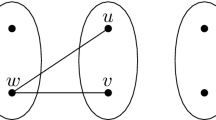Abstract
A vertex (edge) coloring c∶V → {1, 2, ⋯, t} (c′∶E → {1, 2, ⋯, t}) of a graph G=(V, E) is a vertex (edge) t-ranking if for any two vertices (edges) of the same color every path between them contains a vertex (edge) of larger color. The vertex ranking number χ r (G) (edge ranking number \(\chi '_r \left( G \right)\)) is the smallest value of t such that G has a vertex (edge) t-ranking. In this paper we study the algorithmic complexity of the VERTEX RANKING and EDGE RANKING problems. Among others it is shown that χ r (G) can be computed in polynomial time when restricted to graphs with treewidth at most k for any fixed k. We characterize those graphs where the vertex ranking number χ r and the chromatic number χ coincide on all induced subgraphs, show that χ r (G)=χ(G) implies χ(G)=ω(G) (largest clique size) and give a formula for \(\chi '_r \left( {K_n } \right)\).
This author was partially supported by the ESPRIT Basic Research Actions of the EC under contract 7141 (project ALCOM II)
This author was partially supported by the Office of Naval Research under Grant No. N0014-91-J-1693
Research of this author was done while he visited IRISA, Rennes Cedex, France. This author was partially supported by Deutsche Forschungsgemeinschaft under Kr 1371/1-1
This author was partially supported by the “OTKA” Research Fund of the Hungarian Academy of Sciences, Grant No. 2569
Preview
Unable to display preview. Download preview PDF.
Similar content being viewed by others
References
H.L. BODLAENDER. A linear time algorithm for finding tree-decompositions of small treewidth. Proceedings of the 25th Annual ACM Symposium on Theory of Computing, ACM Press, New York, 1993, pp. 226–234.
H.L. BODLAENDER. A tourist guide through treewidth. Acta Cybernetica 11 (1993), 1–23.
H.L. BODLAENDER, J.R. GILBERT, H. HAFSTEINSSON, T. KLOKS. Approximating treewidth, pathwidth and minimum elimination tree height. Proceedings of the 17th International Workshop on Graph-Theoretic Concepts in Computer Science WG'91, Springer-Verlag, Lecture Notes in Computer Science 570, 1992, pp. 1–12. To appear in Journal of Algorithms.
J.A. BONDY, U.S.R. MURTY. Graph Theory with Applications. American Elsevier, New York, 1976.
A. BRANDSTÄDT. Special graph classes — a survey. Schriftenreihe des FB Mathematik, Universität Duisburg, SM-DU-199, 1991.
P. DE LA TORRE, R. GREENLAW, A.A. SCHÄFFER. Optimal edge ranking of trees in polynomial time. Proceedings of the 4th Annual ACM-SIAM Symposium on Discrete Algorithms, Austin, Texas, 1993, pp. 138–144.
J.S. DEOGUN, T. KLOKS, D. KRATSCH, H. MÜLLER. On vertex ranking for permutation and other graphs. Proceedings of the 11th Annual Symposium on Theoretical Aspects of Computer Science, P. Enjalbert, E.W. Mayr, K.W. Wagner, (eds.), Lecture Notes in Computer Science 775, Springer-Verlag, Berlin, 1994, 747–758.
J.S. DEOGUN, Y. PENG. Edge ranking of trees. Congressus Numerantium 79 (1990), 19–28.
I.S. DUFF, J.K. REID. The multifrontal solution of indefinite sparse symmetric linear equations. ACM Transactions on Mathematical Software 9 (1983), 302–325.
M.R. GAREY, D.S. JOHNSON. Computers and Intractability: A Guide to the Theory of NP-completeness. W.H. Freeman and Company, New York, 1979.
M.C. GOLUMBIC. Algorithmic Graph Theory and Perfect Graphs. Academic Press, New York, 1980.
A.V. IYER, H.D. RATLIFF, G. VIJAYAN. Optimal node ranking of trees. Information Processing Letters 28 (1988), 225–229.
A.V. IYER, H.D. RATLIFF, G. VIJAYAN. Parallel assembly of modular products-an analysis. Technical Report 88-06, Georgia Institute of Technology, 1988.
A.V. IYER, H.D. RATLIFF, G. VIJAYAN. On an edge ranking problem of trees and graphs. Discrete Applied Mathematics 30 (1991), 43–52.
M. KATCHALSKI, W. MC CUAIG, S. SEAGER. Ordered colourings. Manuscript, University of Waterloo, 1988.
T. KLOKS. Treewidth. Ph. D. Thesis, Utrecht University, The Netherlands, 1993.
C.E. LEISERSON. Area efficient graph layouts for VLSI. Proceedings of the 21st Annual IEEE Symposium on Foundations of Computer Science, 1980, pp. 270–281.
J.W.H. LIU. The role of elimination trees in sparse factorization. SIAM Joural of Matrix Analysis and Applications 11 (1990), 134–172.
J. NEVINS, D. WHITNEY, (eds.) Concurrent Design of Products and Processes. McGraw-Hill, New York, 1989.
A. POTHEN. The complexity of optimal elimination trees. Technical Report CS-88-13, Pennsylvania State University, U.S.A., 1988.
N. ROBERTSON, P. D. SEYMOUR. Graph minors. IV. Tree-width and well-quasi-ordering. Journal on Combinatorial Theory Series B 48 (1990), 227–254.
N. ROBERTSON, P. D. SEYMOUR. Graph minors. V. Excluding a planar graph. Journal on Combinatorial Theory Series B 41 (1986), 92–114.
N. ROBERTSON, P. D. SEYMOUR. Graph minors. XIII. The disjoint paths problem. Manuscript, 1986.
A.A. SCHÄFFER. Optimal node ranking of trees in linear time. Information Processing Letters 33 (1989/90), 91–96.
P. SCHEFFLER. Node ranking and searching on graphs (Abstract), in: U. Faigle and C. Hoede, (eds.), 3rd Twente Workshop on Graphs and Combinatorial Optimization, Memorandum No. 1132, Faculty of Applied Mathematics, University of Twente, The Netherlands, 1993.
A. SEN, H. DENG, S. GUHA. On a graph partition problem with application to VLSI layout. Information Processing Letters 43 (1992), 87–94.
E.S. WOLK. The comparability graph of a tree. Proceedings of the American Mathematical Society 3 (1962), 789–795.
Author information
Authors and Affiliations
Editor information
Rights and permissions
Copyright information
© 1995 Springer-Verlag Berlin Heidelberg
About this paper
Cite this paper
Bodlaender, H.L. et al. (1995). Rankings of graphs. In: Mayr, E.W., Schmidt, G., Tinhofer, G. (eds) Graph-Theoretic Concepts in Computer Science. WG 1994. Lecture Notes in Computer Science, vol 903. Springer, Berlin, Heidelberg. https://doi.org/10.1007/3-540-59071-4_56
Download citation
DOI: https://doi.org/10.1007/3-540-59071-4_56
Published:
Publisher Name: Springer, Berlin, Heidelberg
Print ISBN: 978-3-540-59071-2
Online ISBN: 978-3-540-49183-5
eBook Packages: Springer Book Archive




